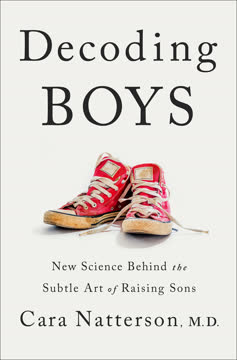Key Takeaways
1. Open Communication is the Cornerstone of Raising Boys
Because if you don’t have the conversations, someone else will: a friend who’s got it all wrong, or a family member who doesn’t exactly share your ideology, or the Internet with its endless treasure trove of image-based content, presenting still pictures and videos that, once viewed, your son can never un-see.
Breaking the Silence. The most significant takeaway is the critical need for open and ongoing communication with boys about their physical, emotional, and social development. The societal norm of boys' silence can be detrimental, leaving them unprepared for adulthood. Parents must actively engage in conversations, even when sons seem resistant, to ensure they receive accurate information and guidance.
Talking Tips. The book offers practical advice on how to initiate and maintain these conversations, including:
- Listening actively
- Finding teachable moments
- Being patient
- Identifying trusted surrogates for sensitive topics
Parental Discomfort. Parents' discomfort with certain subjects should not hinder these crucial discussions. Overcoming personal hesitations is essential to providing sons with the support and knowledge they need to navigate adolescence successfully.
2. Testosterone's Influence Extends Beyond Physicality
Testosterone sits at the center of maleness in every way, responsible for much more than bulk and belligerence.
Hormonal Impact. Testosterone, often associated with aggression and physical changes, plays a much broader role in male development. It influences everything from fetal development to bone density, sex drive, and even mood. Understanding testosterone's multifaceted effects is crucial for parents.
Brain Rewiring. Testosterone directly impacts the male brain, rewiring neurons and influencing emotional responses, risk-taking behavior, and decision-making. This hormonal influence contributes to the mood swings and impulsivity often observed in adolescent boys.
Addressing the Quiet. While a direct link between testosterone and the silence of pubescent boys is not definitively proven, the book emphasizes the importance of maintaining open communication despite this silence. Parents should insist on regular check-ins to stay connected with their sons' lives and experiences.
3. Early Puberty in Boys is More Common Than Realized
Yes, your nine-year-old might be in puberty.
Shifting Timelines. Puberty in boys is starting earlier than previously thought, with many experiencing the first signs around age nine or ten. This shift often goes unnoticed because the initial changes are subtle and internal, primarily involving testicular growth.
Visibility Issue. Unlike the more visible changes in girls, early puberty in boys is often missed by parents and even pediatricians. This lack of awareness can leave boys feeling confused and unprepared for the physical and emotional changes they are experiencing.
Addressing the Shift. Parents need to be aware of the possibility of early puberty and be prepared to have age-appropriate conversations with their sons about the changes they may be experiencing. Normalizing these changes and providing accurate information can help alleviate anxiety and promote healthy development.
4. Late Blooming Carries Social and Emotional Burdens
For late-blooming boys, the longer they go without the physical signs of adulthood, the further askew they may feel during a time in life that is already famously off-balance to begin with.
Delayed Development. Late bloomers, defined as boys who haven't entered puberty by age fourteen, face unique challenges. They often experience a double whammy of delayed physical development and slower growth, leading to feelings of social isolation and inadequacy.
Emotional Toll. Late blooming can have significant social and emotional consequences, including:
- Low self-esteem
- Poor school performance
- Aggression
- Social immaturity
Taking Action. Parents of late-blooming boys should advocate for their sons' well-being by:
- Opening lines of communication
- Seeking medical evaluation
- Providing social and emotional support
5. Brain Development Lags Behind Physical Maturity
When they look like adults but don’t think like them.
Maturity Mismatch. While boys may develop physically, their brains continue to mature well into their twenties. This disconnect between physical appearance and cognitive development can lead to unrealistic expectations and poor decision-making.
Brain Basics. Brain development involves two key processes:
- Growth and shrinkage (synaptic pruning)
- Myelination
Prefrontal Cortex. The prefrontal cortex, responsible for planning, impulse control, and emotional regulation, is one of the last areas of the brain to mature. This delayed development explains why teenagers often make impulsive or irrational decisions.
Parenting Strategies. Parents can help bridge this gap by:
- Teaching pausing strategies
- Explaining brain development
- Setting clear boundaries and expectations
6. Navigating the 21st Century Landscape of Sex Education
The goal of this chapter is to shine a light on what kids need to know about the path to sex, how they get those “facts,” and the different ways the information is parsed out to guys and girls.
Information Overload. Today's youth are bombarded with information about sex from various sources, including:
- Music
- Media
- Friends
- The Internet
Parental Disconnect. A significant disconnect exists between parents' perception of sex education and their children's actual knowledge and experiences. Parents often overestimate their role in providing sex education, while children rely on less reliable sources.
New Educators. The rise of online content creators, such as YouTubers and comedians, has transformed sex education. These atypical messengers often reach a wider audience and address topics that traditional sources may avoid.
Parental Role. Parents still play a crucial role in providing accurate and age-appropriate information about sex. They should strive to be a trusted source of information and create an open dialogue with their children.
7. Pornography's Impact on Boys: A Call for Awareness
In order to be able to talk through all of these charged topics—not just muster the courage to bring them up but actually get the conversations going—we must put a foot in the ever-slamming door.
Porn's Dominance. Pornography is pervasive in today's culture, with a significant percentage of internet downloads and search engine requests being porn-related. Boys are particularly vulnerable to its influence, with many being exposed to it at a young age.
Harmful Effects. Exposure to pornography can have several negative consequences, including:
- Erectile dysfunction
- Unrealistic sexual expectations
- Normalization of violence and degradation
Taking Action. Parents need to be aware of the potential impact of pornography and take steps to protect their sons by:
- Talking openly about pornography
- Setting boundaries and monitoring internet use
- Promoting healthy attitudes towards sex and relationships
8. Body Image Pressures Affect Boys Differently
It’s simply a visibility issue, intimately connected to the nature of how boys versus girls actually begin to blossom.
Male Body Ideals. Boys face increasing pressure to achieve a specific body type, characterized by muscularity and leanness. This pressure can lead to body dissatisfaction and unhealthy behaviors.
The Double Standard. While girls are often encouraged to talk about their body image struggles, boys are often discouraged from expressing their insecurities. This silence can exacerbate the problem and make it harder for boys to seek help.
Taking Action. Parents can help their sons navigate body image pressures by:
- Promoting a healthy lifestyle
- Challenging unrealistic beauty standards
- Encouraging open communication
- Seeking professional help when needed
9. Addiction's Roots in the Reward Circuitry of the Brain
Talking is associated with a stronger sense of self, as well as reduced risk-taking or more forethought (or…wait for it…both!).
Reward Pathways. Addiction is rooted in the brain's reward circuitry, where certain substances and behaviors trigger the release of dopamine, creating feelings of pleasure and motivation. This reward system can be hijacked by addictive substances and behaviors, leading to compulsive engagement despite negative consequences.
Vulnerability. Adolescents are particularly vulnerable to addiction due to their developing brains, where the reward system is more sensitive and the prefrontal cortex, responsible for impulse control, is not yet fully mature.
Prevention Strategies. Parents can help prevent addiction by:
- Educating their children about the risks of addictive substances and behaviors
- Setting clear boundaries and expectations
- Promoting healthy coping mechanisms
- Seeking professional help when needed
10. Gun Violence: A Male Problem Demanding Attention
Obviously girl puberty is visible to everyone—it’s very public,” she continued, “Everyone can see the breasts developing. And menses is public, at least within the family. You can’t miss it. Whereas in boys, the first sign of puberty—they don’t even know themselves, probably. The testes start to enlarge and it’s very subtle. The parents certainly don’t see it.
Disproportionate Impact. Gun violence is disproportionately a male problem, with the vast majority of perpetrators and victims being male. This trend is particularly evident in school shootings, where the perpetrators are almost exclusively young males.
Contributing Factors. Several factors contribute to this trend, including:
- Testosterone
- Socialization
- Access to firearms
- Exposure to trauma
Taking Action. Parents can help address gun violence by:
- Promoting responsible gun ownership
- Challenging toxic masculinity
- Seeking mental health support for at-risk youth
- Advocating for gun control measures
Last updated:
FAQ
1. What is Decoding Boys: New Science Behind the Subtle Art of Raising Sons by Cara Natterson about?
- Comprehensive puberty guide: The book explores the physical, emotional, and social changes boys experience from ages eight to their early twenties, demystifying the complexities of male adolescence.
- Focus on communication: Natterson emphasizes the importance of open, ongoing conversations between parents and sons, countering the cultural silence that often surrounds boys’ development.
- Science meets parenting: Drawing on her expertise as a pediatrician, the author blends medical insights with practical parenting strategies to help families navigate puberty and adolescence.
2. Why should I read Decoding Boys by Cara Natterson?
- Fills a critical information gap: While resources for girls abound, boys often lack accessible, age-appropriate information about puberty; this book addresses that void with clarity and empathy.
- Empowers parental communication: Natterson provides actionable advice for parents to engage their sons in meaningful dialogue about body changes, emotions, and social pressures.
- Addresses modern challenges: The book tackles contemporary issues like online pornography, addiction, body image, and violence, equipping parents to support boys in today’s world.
3. What are the key takeaways from Decoding Boys about talking to boys during puberty?
- Start early and often: Initiate conversations about puberty and related topics before discomfort sets in, and continue them regularly as boys grow.
- Active listening and patience: Listen more than you speak, ask open-ended questions, and allow boys to break silences in their own time.
- Create comfortable settings: Use indirect settings like car rides or bedtime to ease awkwardness, and minimize distractions by turning off devices.
- Use teachable moments: Leverage real-life examples and identify trusted adults as surrogates for when boys won’t talk directly to parents.
4. How does Decoding Boys by Cara Natterson explain the role of testosterone and other hormones in boy puberty and behavior?
- Testosterone’s broad impact: Testosterone drives male physical development, sex drive, and mood, and shapes the adolescent brain through neuron growth and myelination.
- Not the only hormone: Adrenal androgens, not testosterone, are mainly responsible for hair growth, acne, and body odor, clarifying common misconceptions.
- Mood and behavior effects: Rising testosterone influences the amygdala and prefrontal cortex, contributing to mood swings, risk-taking, and impulsivity.
- Silence and hormones: While boys’ withdrawal often coincides with rising testosterone, there’s no definitive proof of causation; parents must persist in communication regardless.
5. What does Decoding Boys say about the timing of puberty in boys, including early and late bloomers?
- Earlier onset is common: Boys are entering puberty earlier than in previous generations, sometimes as young as nine, though changes are often subtle.
- Late bloomers’ challenges: Boys who haven’t started puberty by age fourteen may feel isolated and less mature, representing about 2.5% of boys.
- Constitutional delay explained: Most late bloomers have a benign genetic delay, but medical evaluation is important to rule out other causes.
- Support and intervention: Open communication, counseling, and sometimes hormone therapy can help late bloomers cope with social and emotional impacts.
6. How does Decoding Boys describe adolescent brain development and its impact on boys’ decision-making?
- Brain matures slower than body: While physical puberty takes 5-6 years, the prefrontal cortex (impulse control, planning) matures into the mid-to-late twenties.
- Limbic system dominance: The emotional, risk-taking limbic system matures earlier, leading to impulsive decisions, especially in peer settings.
- Myelination and pruning: The brain strengthens used neural pathways and eliminates unused ones, improving efficiency but requiring time and experience.
- Parenting implications: Understanding brain development helps parents set realistic expectations, teach pausing strategies, and avoid expecting adult-like judgment from teens.
7. What are the main puberty-related body changes in boys explained in Decoding Boys?
- Physical transformations: Boys experience acne, body odor, growth spurts, hair growth (pubic, facial, body), voice changes, erections, and wet dreams, all driven by hormonal changes.
- Variability and unpredictability: The timing and sequence of these changes vary widely, and there is no single “normal” timeline.
- Managing changes: Natterson offers practical tips for handling acne, body odor, mood swings, and other symptoms to help boys navigate puberty confidently.
8. How does Decoding Boys by Cara Natterson address body image issues in boys?
- Boys face unique pressures: Boys struggle with body image at rates similar to girls, but their ideals focus on muscularity and strength rather than thinness.
- Silent suffering: Boys often lack the language or social support to discuss body image, leading to hidden struggles with eating disorders, supplement use, and even steroid abuse.
- Gender-neutral conversations: The book advocates for open, inclusive discussions about body image, encouraging parents to address boy-specific pressures and normalize these topics.
- Focus on health, not weight: Natterson recommends shifting conversations from weight to overall health and well-being.
9. What does Decoding Boys say about boys, pornography, and the importance of parental dialogue?
- Early and easy access: Boys often encounter pornography as early as age ten, coinciding with getting their first smartphones.
- Communication gap: Boys are more likely than girls to watch porn but are socialized to remain silent about it, creating a disconnect with parents.
- Risks of silence: Without open dialogue, boys may internalize unrealistic or harmful messages about sex, consent, and relationships.
- Start early, stay open: Natterson urges parents to begin nonjudgmental conversations about porn before device access and to keep the dialogue ongoing.
10. How does Decoding Boys by Cara Natterson address addiction risks and prevention in boys?
- Developing brain vulnerability: Boys’ reward circuits are still maturing, making them more susceptible to addiction from substances and behaviors like gaming, vaping, and pornography.
- Dopamine’s role: Addiction is linked to dopamine release in the brain’s reward centers, and repeated stimulation can hardwire addictive patterns in adolescents.
- Delay as prevention: Delaying exposure to addictive substances and behaviors is a key prevention strategy, along with substituting healthier activities.
- Communication and support: Parents are encouraged to be the “fall guy” for boys to use as an excuse to refuse peer pressure and to approach concerns calmly and privately.
11. What does Decoding Boys by Cara Natterson say about boys, guns, and violence?
- Male predominance in violence: The vast majority of school shooters and gun-related homicides are young males with access to firearms.
- Complex shooter profiles: While there’s no single profile, common traits include youth, maleness, trauma history, social isolation, and mental health challenges.
- Video games and aggression: The book notes no direct causal link between violent video games and shootings but discusses how gaming may normalize aggression and affect mood.
- Parental oversight: Natterson recommends cautious monitoring of gaming and open conversations about violence and emotional health.
12. What are the best quotes from Decoding Boys by Cara Natterson and what do they mean?
- “Not talking to your son about his evolving physical, emotional, and social self is the biggest parent trap of them all.” This highlights the danger of accepting boys’ silence instead of engaging them in conversation.
- “He needs to know, too. And that means we need to talk to them, even when our sons go quiet.” Emphasizes the necessity of persistent communication despite boys’ withdrawal.
- “Talking is associated with a stronger sense of self, as well as reduced risk-taking or more forethought.” Underlines the protective power of open dialogue.
- “The grass is sometimes greener.” Reminds parents and boys that puberty is unpredictable and what seems like an advantage one day may change the next, encouraging patience and perspective.
Review Summary
Decoding Boys receives generally positive reviews for its insightful approach to understanding male puberty and adolescence. Readers appreciate the scientific explanations and practical advice for communicating with boys. Many find it eye-opening and valuable for parents and educators. Some criticize its heteronormative focus and repetitive advice. The book is praised for addressing topics like pornography, addiction, and body image. While some find it overly scientific, others appreciate the depth of information. Overall, it's considered a helpful resource for navigating the challenges of raising teenage boys.
Similar Books
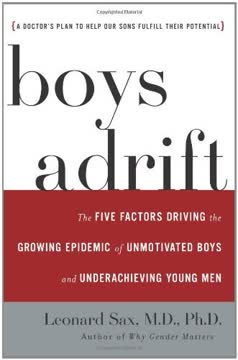


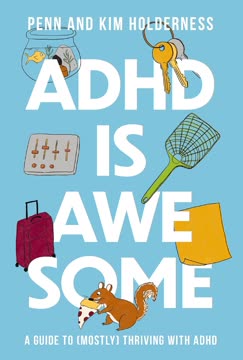
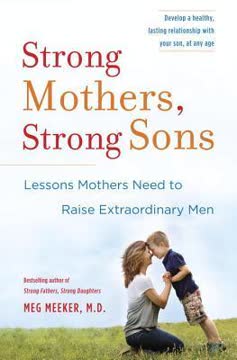
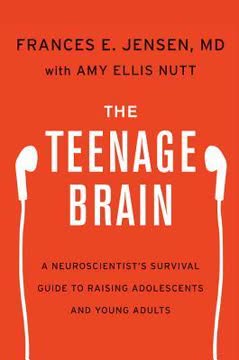




Download PDF
Download EPUB
.epub digital book format is ideal for reading ebooks on phones, tablets, and e-readers.
